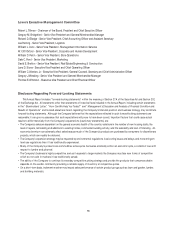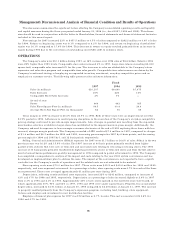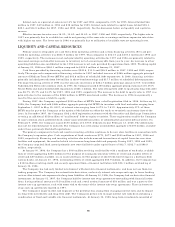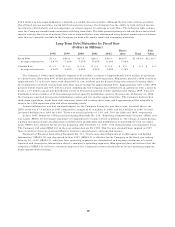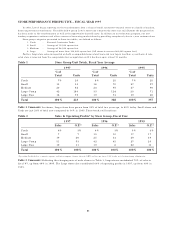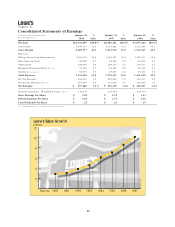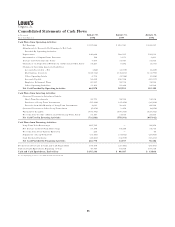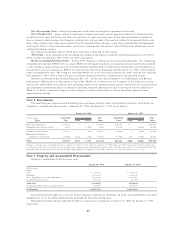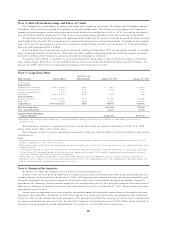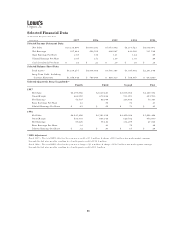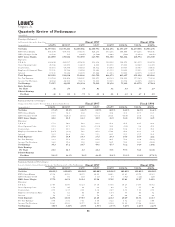Lowe's 1997 Annual Report Download - page 28
Download and view the complete annual report
Please find page 28 of the 1997 Lowe's annual report below. You can navigate through the pages in the report by either clicking on the pages listed below, or by using the keyword search tool below to find specific information within the annual report.
Notes to Consolidated Financial Statements
Fiscal Years Ended January 30, 1998, January 31, 1997 and 1996
Note 1, Summary of Significant Accounting Policies:
The Company is one of the largest retailers serving the do-it-yourself home improvement, home decor, and home construction
markets in the United States. The Company serves customers in 446 stores in 25 states predominantly located in the eastern
half of the United States. Below are those accounting policies considered to be significant.
Fiscal Year – Effective February 1, 1997, the Company adopted a 52 or 53 week fiscal year, changing the year end date
from January 31 to the Friday nearest January 31. The fiscal year ended January 30, 1998 had 52 weeks. All references herein
for the years 1997, 1996 and 1995 represent the fiscal years ended January 30, 1998 and January 31, 1997 and 1996, respectively.
Principles of Consolidation – The consolidated financial statements include the accounts of the Company and its subsidiaries,
all of which are wholly owned. All material intercompany accounts and transactions have been eliminated.
Use of Estimates – The preparation of the Company’s financial statements in conformity with generally accepted accounting
principles requires management to make estimates and assumptions that affect the reported amounts of assets and liabilities
and disclosure of contingent assets and liabilities at the date of the financial statements and reported amounts of revenues
and expenses during the reporting period. Actual results could differ from those estimates.
Cash and Cash Equivalents – Cash and cash equivalents include cash on hand, demand deposits, and short-term invest-
ments with original maturities of three months or less when purchased.
Investments – The Company has a cash management program which provides for the investment of excess cash balances in
financial instruments which have maturities of up to five years. Investments, exclusive of cash equivalents, with a maturity of
one year or less from the balance sheet date are classified as short-term investments. Investments with maturities greater than
one year are classified as long-term. Investments consist primarily of tax-exempt notes and bonds, municipal preferred tax-exempt
stock and repurchase agreements.
The Company has classified all investment securities as available-for-sale and they are carried at fair value. Unrealized
gains and losses on such securities are excluded from earnings and reported as a separate component of shareholders’ equity,
net of the related income taxes, until realized.
Derivatives – The Company does not use derivative financial instruments for trading purposes. Interest rate swap agree-
ments, which are principally used by the Company in the management of interest rate exposure, are accounted for on an
accrual basis. Income and expense are recorded in the same category as that arising from the related liability. Amounts to be
paid or received under interest rate swap agreements are recognized as interest income or expense in the periods in which
they accrue.
Premiums paid for purchased interest rate cap agreements are amortized to interest expense over the terms of the caps.
Unamortized premiums are included in other assets in the consolidated balance sheet. Amounts to be received under the cap
agreements are accounted for on an accrual basis, and are recognized as a reduction of interest expense. The Company had
no derivative financial instruments at January 30, 1998.
Accounts Receivable – The majority of the accounts receivable arise from sales to professional building contractors. The
allowance for doubtful accounts is based on historical experience and a review of existing receivables. The allowance for
doubtful accounts was $1.6 and $2.3 million at January 30, 1998 and January 31, 1997, respectively.
Sales generated through the Company’s private label credit card are not reflected in receivables. Under an agreement
with Monogram Credit Card Bank of Georgia (the Bank), a wholly owned subsidiary of General Electric Capital Corporation,
consumer credit is extended directly to customers by the Bank and all credit program related services are performed directly
by the Bank.
Merchandise Inventory – Inventory is stated at the lower of cost or market. In an effort to more closely match cost of
sales and related sales, cost is determined using the last-in, first-out (LIFO) method. Included in inventory cost are adminis-
trative, warehousing and other costs directly associated with buying, distributing and maintaining inventory in a condition
for resale.
If the FIFO method had been used, inventories would have been $67.6 and $74.6 million higher at January 30, 1998
and January 31, 1997, respectively.
Property and Depreciation – Property is recorded at cost. Costs associated with major additions are capitalized and
depreciated. Upon disposal, the cost of properties and related accumulated depreciation is removed from the accounts with
gains and losses reflected in earnings.
Depreciation is provided over the estimated useful lives of the depreciable assets. Assets are generally depreciated on the
straight-line method. Leasehold improvements are depreciated over the shorter of their estimated useful lives or term of the
related lease.
Leases – Assets under capital leases are amortized in accordance with the Company’s normal depreciation policy for
owned assets or over the lease term if shorter and the charge to earnings is included in depreciation expense in the consolidated
financial statements.
Income Taxes – Income taxes are provided for temporary differences between the tax and financial accounting bases of
assets and liabilities using the liability method. The tax effects of such differences are reflected in the balance sheet at the
enacted tax rates expected to be in effect when the differences reverse.
2 6


